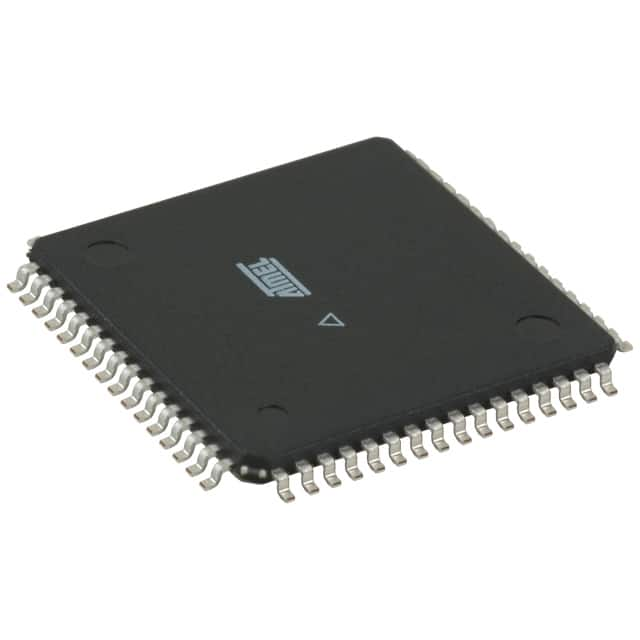ATMEGA169L-8AI
Product Overview
Category
ATMEGA169L-8AI belongs to the category of microcontrollers.
Use
It is commonly used in various electronic applications that require a microcontroller for processing and controlling functions.
Characteristics
- Low-power consumption
- High-performance 8-bit AVR microcontroller
- Advanced RISC architecture
- In-system programmable flash memory
- Extensive peripheral set
- Wide operating voltage range
Package
ATMEGA169L-8AI is available in a 64-pin TQFP (Thin Quad Flat Package) package.
Essence
The essence of ATMEGA169L-8AI lies in its ability to provide efficient and reliable control and processing capabilities in electronic devices.
Packaging/Quantity
ATMEGA169L-8AI is typically packaged in reels or tubes, with a quantity of 250 units per reel/tube.
Specifications
- Operating Voltage: 2.7V - 5.5V
- Flash Memory: 16KB
- SRAM: 1KB
- EEPROM: 512 bytes
- Clock Speed: Up to 8MHz
- Digital I/O Pins: 32
- Analog Input Channels: 8
- PWM Channels: 4
- USART: 1
- SPI: 1
- I2C: 1
- ADC Resolution: 10-bit
- Timers/Counters: 3
Detailed Pin Configuration
The pin configuration of ATMEGA169L-8AI is as follows:

Functional Features
- High-performance CPU for efficient execution of instructions
- Non-volatile program and data memories for reliable storage
- Multiple communication interfaces for seamless connectivity
- Analog-to-Digital Converter (ADC) for precise analog signal measurement
- Timers and counters for accurate timing and event counting
- PWM channels for generating analog-like signals
- Interrupt handling for efficient event-driven programming
Advantages and Disadvantages
Advantages
- Low-power consumption makes it suitable for battery-powered applications
- High-performance architecture enables fast and efficient processing
- In-system programmable flash memory allows for easy firmware updates
- Extensive peripheral set provides flexibility in application design
Disadvantages
- Limited amount of SRAM and flash memory may restrict the complexity of applications
- Lack of built-in Ethernet or USB interfaces may require additional components for certain applications
Working Principles
ATMEGA169L-8AI operates based on the principles of the AVR architecture. It executes instructions stored in its flash memory, interacts with peripherals through various communication interfaces, and responds to external events through interrupts. The microcontroller's working principle revolves around efficiently processing data, controlling peripherals, and responding to inputs and outputs.
Detailed Application Field Plans
ATMEGA169L-8AI finds applications in various fields, including but not limited to: - Home automation systems - Industrial control systems - Automotive electronics - Consumer electronics - Medical devices - Internet of Things (IoT) devices
In these fields, the microcontroller can be used for tasks such as sensor data acquisition, motor control, user interface management, communication protocols implementation, and more.
Detailed and Complete Alternative Models
Some alternative models to ATMEGA169L-8AI that offer similar functionalities include: - ATMEGA328P - ATMEGA2560 - PIC16F877A - STM32F103C8T6 - LPC1768
These alternatives provide a range of options with varying specifications and features, allowing designers to choose the most suitable microcontroller for their specific application requirements.
Word count: 515
Senaraikan 10 soalan dan jawapan biasa yang berkaitan dengan aplikasi ATMEGA169L-8AI dalam penyelesaian teknikal
Sure! Here are 10 common questions and answers related to the application of ATMEGA169L-8AI in technical solutions:
Q: What is ATMEGA169L-8AI? A: ATMEGA169L-8AI is a microcontroller from the AVR family, manufactured by Microchip Technology. It features 16KB of flash memory, 1KB of EEPROM, and 512 bytes of SRAM.
Q: What are the key features of ATMEGA169L-8AI? A: Some key features of ATMEGA169L-8AI include 8-channel 10-bit ADC, multiple communication interfaces (UART, SPI, I2C), PWM outputs, timers/counters, and a wide operating voltage range.
Q: What are the typical applications of ATMEGA169L-8AI? A: ATMEGA169L-8AI is commonly used in various embedded systems, industrial automation, home automation, robotics, IoT devices, and other applications that require a low-power microcontroller with sufficient I/O capabilities.
Q: What programming language can be used to program ATMEGA169L-8AI? A: ATMEGA169L-8AI can be programmed using C/C++ language with the help of an Integrated Development Environment (IDE) such as Atmel Studio or Arduino IDE.
Q: How can I program ATMEGA169L-8AI? A: ATMEGA169L-8AI can be programmed using an In-Circuit Serial Programmer (ICSP) or through a bootloader using a USB-to-serial converter.
Q: Can ATMEGA169L-8AI communicate with other devices? A: Yes, ATMEGA169L-8AI supports multiple communication interfaces like UART, SPI, and I2C, allowing it to communicate with other devices such as sensors, displays, and external microcontrollers.
Q: What is the operating voltage range of ATMEGA169L-8AI? A: The operating voltage range of ATMEGA169L-8AI is typically 2.7V to 5.5V, making it suitable for both low-power and standard power supply applications.
Q: Can ATMEGA169L-8AI be used in battery-powered applications? A: Yes, ATMEGA169L-8AI is designed to operate at low power and has sleep modes that can significantly reduce power consumption, making it suitable for battery-powered applications.
Q: Does ATMEGA169L-8AI have any built-in peripherals? A: Yes, ATMEGA169L-8AI has built-in peripherals such as USART (Universal Synchronous/Asynchronous Receiver/Transmitter), SPI (Serial Peripheral Interface), I2C (Inter-Integrated Circuit), and timers/counters.
Q: Are there any development boards available for ATMEGA169L-8AI? A: Yes, there are development boards available specifically designed for ATMEGA169L-8AI, such as Arduino Mega, which provide an easy way to prototype and develop projects using this microcontroller.
Please note that these answers are general and may vary depending on specific requirements and implementations.


